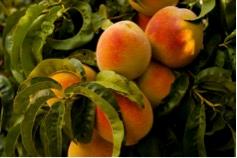Peach
-
Scientific Name(Prunus persica)
-
General InformationKnown as the “queen” of summer fruit, peaches feature fuzzy skin and sweet juicy yellow or white flesh. The trees are easily grown. Peach trees are self-fruiting, with flowers borne on one year old shoots. The trees can live for up to 20 years and adapt very well to the Marin climate.
 Photo: Ian Baldwin, Unsplash
Photo: Ian Baldwin, Unsplash -
When to Plant
Plant dormant, bare root peaches in winter to early spring. By planting then, they get the benefit of cool spring weather. Planting should be done as soon as possible after receiving them from the nursery so their roots do not dry out. Learn more about planting bare root trees.
-
Planting
Plant in raised beds or on a ridge or mound of soil several inches high and several feet across in areas where drainage is poor or soil is highly amended. Avoid planting in a low-lying area to prevent diseases such as root rot, and never plant in saturated or wet soil. Plants will settle as organic matter in the soil decomposes.
-
Soil Requirements
Plant where the soil drains well to about three to five feet down, with a pH of 6.0 to 7.0. It may be best to test soil if planting in a new location. Test for potassium (K), calcium (Ca), magnesium (Mg), and sodium (Na).
-
Water Requirements
Water regularly. The amount of water needed for the tree is primarily dependent upon the size of the tree, time of year, and temperature. It also depends on the type of irrigation being used, whether drip or sprinkler. Drip irrigate daily or use sprinklers about every three weeks.
Water Management For Temperate Fruit Trees (Daily water use (gal/day)
Tree Age/Size Early Spring Warm Spring/Fall Hot Summer Very Hot Summer Dwarf - 2 yrs. 0.62 1.25 1.56 1.87
4 yrs.
6.20 12.5 15.6 18.7 Std. mature 18.6 37.5 46.8 56.1 California Master Gardener Handbook, 6th printing 2013, pg.493
-
Fertilizing
Nitrogen should be applied in the spring, but not to excess as it can cause problems with the fruit and attract numerous pests. Use an organic fertilizer such as blood meal or alfalfa meal. Follow directions on the package. Always water after fertilizing. Also, check for a zinc deficiency, as it will result as small new leaves. Testing soil provides valuable information that allows you to accurately compensate for any deficiencies.
-
Pollination
Peach trees are self-fertile, thus they do not need another tree to bear fruit.
-
Harvesting
Peaches generally ripen on the tree. Harvest when the fruit is firm, but not soft and has a peach aroma. Taste check for ripeness. To avoid insects on the fruit, harvest when firm and ripen indoors in paper bags or bowls.
-
Storage
Peaches are best if eaten within a few days after ripening, but can keep in the refrigerator for up to two weeks.
-
Good Varieties for Marin
Peach trees come in standard or dwarf sizes
'Babcock': Medium-sized. White flesh. Freestone, low chill variety.
'Earligrande': Excellent flavor. Yellow-red blush. Semi-freestone, low chill variety.
'Fairtime': Large fruit. Yellow, firm flesh. Excellent flavor.
'Indian Blood': Cling peach. Red skin and flesh. Tart. Prolific.
'La Feliciana': Medium-sized. Firm, red. Excellent flavor. Somewhat more disease resistant.
'Loring': Very large fruit. Red skin. Yellow flesh. Freestone. Somewhat more disease resistant.
'Nectar': White flesh. Pink skin. Excellent flavor.
'O'Henry': One of the best. Large fruit. Yellow flesh. Freestone.
'Suncrest': Large fruit. Yellow flesh. Freestone. Midseason.
'Veteran': Red blush. Elberta-type. Freestone. Dependable, heavy producer with excellent flavor. Somewhat more disease resistant.
-
Helpful Tips
Peaches require adequate summer water, deep, well-drained soil, nitrogen fertility, fruit thinning during growing season to a distance of six inches between fruits, and sprays to prevent peach leaf curl and brown rot.
Winter Dormant Season
- Spray trees with dormant oil to control San Jose scale.
- Spray fixed copper to control peach leaf curl December 1 and February 1.
- Prune out 50% of last year’s wood to thin the crop and to ensure good shoot growth and fruiting potential for future years.
Spring Bloom Season
- Apply fungicide during bloom to prevent brown rot, which may require one to three sprays, depending on weather. Rainy periods require more spray.
- Fertilize young trees monthly with organic nitrogen fertilizer beginning April 1. Water well.
- Thin fruits to about six inches apart when marble-sized. Thinning reduces fruit numbers, but increases size and prevents limb breakage.
Summer Growing Season
- Drip irrigate daily or sprinkler irrigate about every three weeks.
- Maintain a weed free area around the base of the trees within three feet of the trunk with an organic mulch three inches deep.
Fall Harvest Season
- Spray for shot hole fungus in November before first heavy rain; use fixed copper.
- Fertilize and irrigate just after harvest.
- At leaf fall, remove and destroy or compost leaves to prevent the spread of peach scab.
- Remove mummies from tree.
Learn more about pruning peach trees.
-
Common Problems
Peach leaf curl and brown rot are common problems. Learn more about problems when growing peaches.
-
Pests- Diseases & More
Learn more about growing peach trees.

